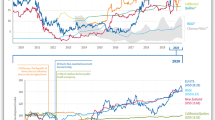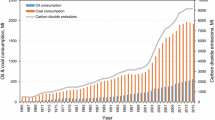Abstract
Carbon management is a strategic priority and organizations need to forecast carbon for that. We aim to find out the best ARIMA-GARCH model for forecasting conditional return and volatility of European Union Allowance (EUA) for all three phases of European Union Emissions Trading Scheme and the Rolled Over series. We use European Climate Exchange Dec 2007, Dec 2012, Dec 2015 expiry and the Rolled Over Dec 2015 expiry future contracts of EUA. The previous studies in this area have focused on a particular subset of EUA data and do not take care of the multicollinearities. We take EUA data from all three phases and the Rolled Over series, adopt principal component analysis to eliminate multicollinearities and then fit GARCH models for comprehensive analysis. The study establishes that the best models for predicting EUA phase I, II, III and Rolled Over series are asymmetric GARCH models.











Similar content being viewed by others
References
Alberola E, Chevallier J (2009) European carbon prices and banking restrictions: evidence from phase I (2005–2007). Energy 30(3):51–80
Alberola E, Chevallier J, Cheze B (2008) The EU emissions trading scheme: the effects of industrial production and \(CO_2\) emissions on european carbon prices. Int Econ 116:93–125
Alberola E, Chevallier J, Cheze B (2009) Emissions compliances and carbon prices under the EU ETS: a country specific analysis of industrial sectors. Policy Model 31(3):446–462
Benz E, Trnck S (2009) Modeling the price dynamics of \({\rm CO}_2\) emission allowances. Energy Econ 31(1):4–15
Bollerslev T (1986) Generalized autoregressive conditional heteroskedasticity. J Econ 31:307–327
Chevallier J (2012) Econometric Analysis of Carbon Markets. Springer, London
Christiansen A, Arvanitakis A, Tangen K, Hasselknippe H (2005) Price determinants in the eu emissions trading scheme. Clim Policy 5(1):15–30
Conrad C, Rittler D, Rotfuss W (2012) Modeling and explaining the dynamics of european union allowance prices at high-frequency. Energy Econ 34(1):316–326
Daskalakis G, Markellos R (2009) Are electricity risk premia affected by emission allowance prices? evidence from the eex, nord pool and powernext. Energy Policy 37(7):2594–2604
Dhamija A, Bhalla V (2011) Exchange rate forecasting: comparison of various architectures of neural networks. Neural Comput Appl 20(3):355–363
Dhamija A, Yadav SS, Jain PK (2015) Price determinants and volatility of carbon permits: a study in the context of european union. PhD Thesis. Department of Managemant Studies, Indian Institute of Technology, Delhi
DTG (2015) Data technology group. https://www.quandl.com/. Accessed 16 July 2015
Ellerman A, Buchner B (2008) Over-allocation or abatement? A preliminary analysis of the eu ets based on the 2005–06 emissions data. Environ Resour Econ 41(2):267–287
Engle RF (1982) Autoregressive conditional heteroscedasticity with estimates of the variance of united kingdom inflations. Econometrica 50:987–1007
Engle RF (2003) Risk and volatility: Econometric models and financial practice. Nobel Lecture
Ghalanos A (2014) rugarch: univariate GARCH models. R package version 1.3-5
Glosten LR, Jagannathan R, Runkle DE (1993) On the relation between the expected value and the volatility of nominal excess return on stocks. J Fin 48:1779–1801
Keppler J, Mansanet-Bataller M (2010) Causalities between \({\rm CO}_2\), electricity, and other energy variables during phase i and phase ii of the EU ETS. Energy Policy 38(7):3329–3341
Konar S, Cohen M (2001) Does the market value environmental performance? Rev Econ Stat 83(2):281–289
Kruger J, Oates W, Pizer W (2007) Decentralization in the EU emissions trading scheme and lessons for global policy. Discussion paper 07-02, Resources for the Future, Washington DC
Kumar S, Managi S, Matsuda A (2012) Stock prices of clean energy firms, oil and carbon markets: a vector autoregressive analysis. Energy Econ 34(1):215–226
Managi S, Managi S, Okimoto T (2013) Does the price of oil interact with clean energy prices in the stock market? MPRA Paper 46067, University Library of Munich, Germany
Managi S, Okimoto T, Matsuda A (2012) Do socially responsible investment indexes outperform conventional indexes? Appl Fin Econ 22(18):1511–1527
Mansanet-Bataller M, Pardo A (2009) Impacts of regulatory announcements on CO\(_2\) prices. J Energy Markets 2(2):77–109
Mansanet-Bataller M, Pardo A, Valor E (2007) CO\(_2\) prices, energy and weather. Energy 28(3–5):73–92
McLeod AI, Li WK (1983) Diagnostic checking arma time series models using squared-residual autocorrelations. J Time Ser Anal 4:269–273
Meyer B (2000) A constraint-based framework for diagrammatic reasoning. Appl Artif Intell 14:327–344
MIG (2015). Market intelligence group sa, enrgy market price. http://energymarketprice.com/. Accessed 20 July 2015
Paolella M, Taschini L (2008) An econometric analysis of emission trading allowances. J Bank Fin 32(10):2022–2032
Ratnatunga J, Balachandran K (2013) Carbon emissions management and the financial implications of sustainability. In: Corporate sustainability. Springer, Berlin, pp 59–87
Roll R (1984) Orange juice and weather. Am Econ Rev 74(5):861–880
Sparks JJ, Yurova YV (2005) Comparative performance of arima and arch/garch models on time series of daily equity prices for large companies. Departmental Internal Report, University of Illinois, Chicago
Tank K (2015) European climate assessment and dataset (eca&d). http://www.ecad.eu/. Accessed 16 July 2015
Tsay RS (2005) Analysis of financial time series. Wiley Interscience, New Jersey
Author information
Authors and Affiliations
Corresponding author
About this article
Cite this article
Dhamija, A.K., Yadav, S.S. & Jain, P. Forecasting volatility of carbon under EU ETS: a multi-phase study. Environ Econ Policy Stud 19, 299–335 (2017). https://doi.org/10.1007/s10018-016-0155-4
Received:
Accepted:
Published:
Issue Date:
DOI: https://doi.org/10.1007/s10018-016-0155-4




